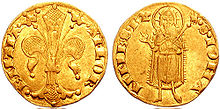Mintmaster's mark
Mint master's mark (abbreviation Mmz.) Are often the first letters of the names of the mint masters of a mint or small symbols (cross, star, coat of arms, device, etc.) about the size of the letters of a coin inscription to identify the minting of coins under their direction . With his mark, the mint master guaranteed that his mint was properly issued. Mint master's marks were already used in the time of the bracteate minting, but these can only rarely be explained. All minting marks have been known since the beginning of the coinage .
The picture on the right shows the mint master's mark “acorn on a stick” of the Dresden mint master Constantin Rothe on a Electoral Saxon Reichstaler Johann Georg II from 1662.
variants


Sometimes there are picture and letter symbols on a coin. In this case, the symbol is usually in the inscription of the coin and the letters are divided in the field on both sides of the coat of arms. Mint masters often used their coats of arms as a mint master's mark. For example in the Electorate of Saxony :
- Constantin Rothe , mint master from 1640 to 1678 in Dresden , put the letters C – R on his minting and also the acorn on the branch from his family coat of arms.
- Andreas Alnpeck , last mint master at the Freiberg mint , used a six-pointed star from 1546 to 1555 and also the eagle head from his coat of arms as a mint master's mark from 1554 to 1555.
- Ernst Peter Hecht , mint master 1693–1714 in Leipzig , used the letters EPH as the mint master's mark and also the pike from his coat of arms.
In Brandenburg:
- Paul Mühlrad , mint master 1538–1542 in Berlin put a mill wheel on his mint .
In Mecklenburg:
- Johann Hund (1512–1526) used a dog as a talking coat of arms and emblem in the corners of the cross on the Rostock Schillingen .
In Florence:
- In addition to the emission symbols, the mint masters also put their coat of arms on Florentine gold coins .
Introduction and replacement of the mint master's mark
The mint master's marks appear from the late Middle Ages. They were largely replaced in the second half of the 19th century by the mintmark in the form of a letter to denote the mint . First, France ( Paris mint ) replaced the mint master's mark with mint marks to designate the mint in the 16th century. The Berlin mint has been using the mintmark A since the middle of the 18th century.
Mintmaster mark, mint mark, signature

Sometimes there is also the signature of the coin engraver or just the artist's signature on coins . The mint master's mark must therefore not be confused with the coin signature .
There is also a risk of confusion with mint marks denoting the mint if the mint master mark consists of only one letter.
Sometimes there are also monograms as a mintmaster's mark, for example in the Weidenbaumtalern of the mint master Terenz Schmidt of the Kassel mint with the intertwined mintmaster's mark “TS”. Monograms are more likely to be found in die cutter signatures and are therefore another risk of confusion.
Exceptionally, however, it can happen that the mint master's mark and the signature of the die cutter are identical on one coin. For example, coins from the Electorate of the Palatinate with the mint mark “AS”. These are the signature and at the same time the mint master's mark of the Electoral Palatinate court medalist, mint die cutter and mint master Anton Schäffer in one person. As an example, see the illustration of the river gold ducat from 1763.
Explainable mint master marks can enable undated and unlocated coins to be identified.
literature
- Heinz Fengler, Gerd Gierow, Willy Unger: transpress Lexikon Numismatics , Berlin 1976
- Paul Arnold, Harald Küthmann, Dirk Steinhilber: Large German coin catalog from 1800 to today , Augsburg 2010
- Julius Erbstein , Albert Erbstein : Discussions in the field of the Saxon coin and medal history when listing the Hofrath Engelhardt'schen collection , Dresden 1888
- Walter Haupt : Saxon coinage. Berlin 1974
- Lienhard Buck: The coins of the Electorate of Saxony 1763 to 1806 , Berlin 1981
- Wolfgang Steguweit : History of the Gotha Mint , Weimar 1987
- Gerhard Krug: The Meissnian Saxon Groschen 1338–1500 , Berlin 1974
- N. Douglas Nicol: Standard Catalog of German Coins 1601 to Present , 1995
- L. Krause, Clifford Mishler: 1991 standard catalog of WORLD COINS 1801-1990
- Friedrich von Schrötter, N. Bauer, K. Regling, A. Suhle, R. Vasmer, J. Wilcke: Dictionary of Coin Studies , Berlin 1970 (reprint of the original edition from 1930)
- Lotar Koppe: The Saxon-Ernestine coins 1551 to 1573 , Regenstauf 2004
Web links
- Mintmaster's mark Numispedia
- Numismatic Society - Schreckenberger ( Memento from May 18, 2005 in the Internet Archive ) (PDF; 266 kB)
- mcsearch.info: Friedrich II. and Wilhelm (III.) 1440–1464. Schildgroschen undated (1451/1456), Poppy head / Stachelrose-Freiberg. 2.13 g. Pitcher 1034/11.
Notes and individual references
- ↑ Output : Number of pieces of a nominal coin that was minted (applied) from a certain weight. See Helmut Kahnt, Bernd Knorr: Old measures, coins and weights. A lexicon. Bibliographisches Institut, Leipzig 1986, licensed edition Mannheim / Vienna / Zurich 1987, ISBN 3-411-02148-9 , p. 381.
- ↑ Staatliche Münze Berlin / History ( Memento from February 14, 2012 in the Internet Archive )
